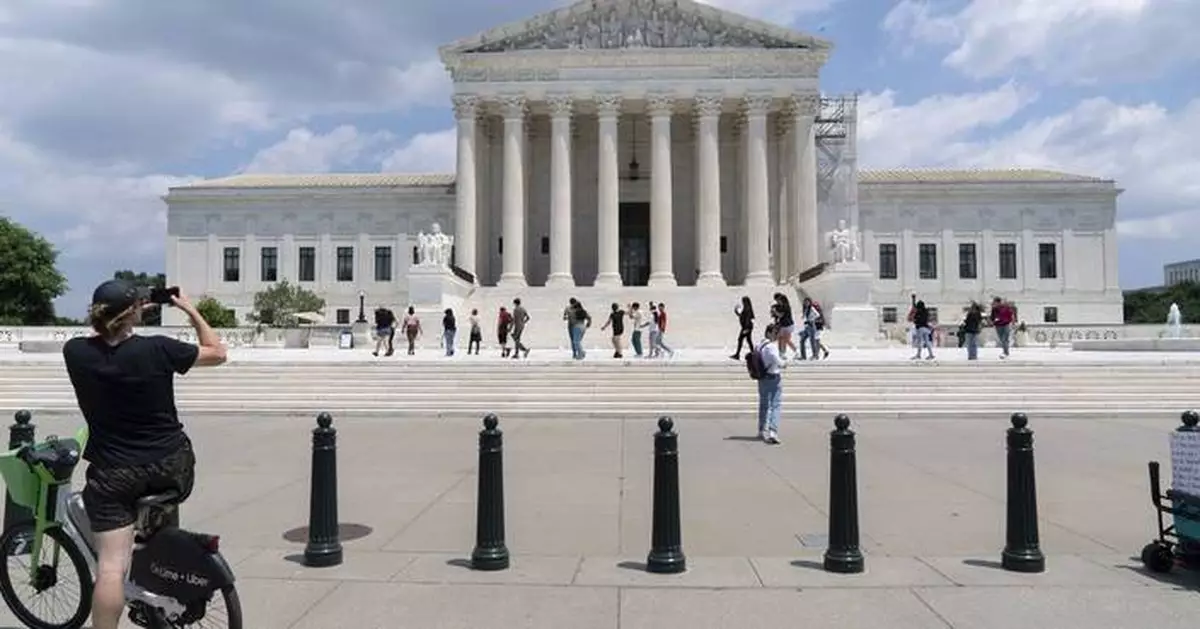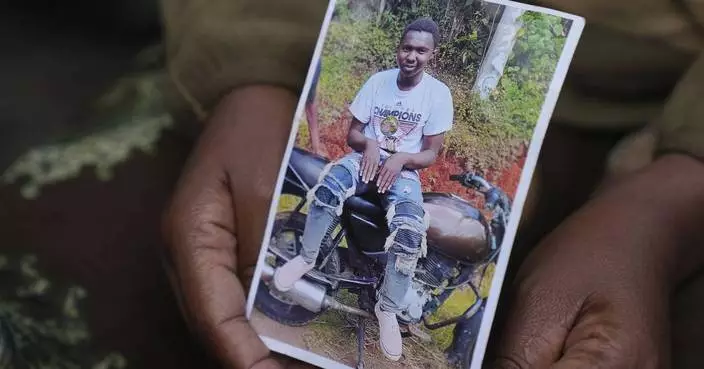WASHINGTON (AP) — The Supreme Court on Wednesday sided with the Biden administration in a dispute with Republican-led states over how far the federal government can go to combat controversial social media posts on topics including COVID-19 and election security.
By a 6-3 vote, the justices threw out lower-court rulings that favored Louisiana, Missouri and other parties in their claims that officials in the Democratic administration leaned on the social media platforms to unconstitutionally squelch conservative points of view.
Click to Gallery
WASHINGTON (AP) — The Supreme Court on Wednesday sided with the Biden administration in a dispute with Republican-led states over how far the federal government can go to combat controversial social media posts on topics including COVID-19 and election security.
The Supreme Court building is seen, Wednesday, June 26, 2024, in Washington. (AP Photo/Alex Brandon)
Visitors pose for photographs outside the U.S. Supreme Court Tuesday, June 18, 2024, in Washington. ( AP Photo/Jose Luis Magana)
The Supreme Court rules for Biden administration in a social media dispute with conservative states
The Supreme Court rules for Biden administration in a social media dispute with conservative states
Visitors pose for photographs at the U.S. Supreme Court Tuesday, June 18, 2024, in Washington. ( AP Photo/Jose Luis Magana)
Justice Amy Coney Barrett wrote for the court that the states and other parties did not have the legal right, or standing, to sue. Justices Samuel Alito, Neil Gorsuch and Clarence Thomas dissented.
The decision should not affect typical social media users or their posts.
The case is among several before the court this term that affect social media companies in the context of free speech. In February, the court heard arguments over Republican-passed laws in Florida and Texas that prohibit large social media companies from taking down posts because of the views they express. In March, the court laid out standards for when public officials can block their social media followers.
The cases over state laws and the one that was decided Wednesday are variations on the same theme, complaints that the platforms are censoring conservative viewpoints.
The states had argued that White House communications staffers, the surgeon general, the FBI and the U.S. cybersecurity agency are among those who applied “unrelenting pressure” to coerce changes in online content on social media platforms.
The justices appeared broadly skeptical of those claims during arguments in March and several worried that common interactions between government officials and the platforms could be affected by a ruling for the states.
The Biden administration underscored those concerns when it noted that the government would lose its ability to communicate with the social media companies about antisemitic and anti-Muslim posts, as well as on issues of national security, public health and election integrity.
White House press secretary Karine Jean-Pierre said the court reached the right outcome because "it helps ensure the Biden Administration can continue our important work with technology companies to protect the safety and security of the American people, after years of extreme and unfounded Republican attacks on public officials who engaged in critical work to keep Americans safe.
Louisiana Attorney General Liz Murrill called the decision “unfortunate and disappointing.” The court majority, Murrill said in a statement, “gives a free pass to the federal government to threaten tech platforms into censorship and suppression of speech that is indisputably protected by the First Amendment. The majority waves off the worst government coercion scheme in history.”
The justices did not weigh in on the substance of the states' claims or the administration's response in their decision Wednesday.
“We begin — and end — with standing,” Barrett wrote. “At this stage, neither the individual nor the state plaintiffs have established standing to seek an injunction against any defendant. We therefore lack jurisdiction to reach the merits of the dispute.”
In dissent, Alito wrote that the states amply demonstrated their right to sue. "For months, high-ranking government officials placed unrelenting pressure on Facebook to suppress Americans’ free speech. Because the court unjustifiably refuses to address this serious threat to the First Amendment, I respectfully dissent,” he wrote for the three justices in the minority.
Some free speech advocates praised the result, but lamented how little guidance the court provided.
“The platforms are attractive targets for official pressure, and so it’s crucial that the Supreme Court clarify the line between permissible attempts to persuade and impermissible attempts to coerce,” said Alex Abdo, litigation director of the Knight First Amendment Institute. "This guidance would have been especially valuable in the months leading up to the election.”
Nina Jankowicz was named in the original lawsuit after being appointed in 2022 to lead a new board within the Department of Homeland Security to tackle disinformation. The board was dissolved within weeks amid conspiracy theories and criticism from Republicans and conservative activists who saw the effort as a political tool to regulate free speech.
Jankowicz, an expert in disinformation, said the Supreme Court had done what she had expected. But she said the damage from the lawsuit is not easily fixed.
“Unfortunately, there is an entire class of people that now believes the government, in coordination with independent researchers, is censoring some part of the American population,” she said. “I don’t think that’s going to go away anytime soon.”
The court’s ruling comes as many social media companies have removed guardrails against hate and disinformation.
The social media platform X, under the leadership of owner Elon Musk, has restored the accounts of conspiracy theorists and extremists who were previously banned. It also has gutted teams that once fought misinformation on the platform, leaving the community of users to moderate itself.
Experts say the shrinking of such teams, a development that many blame on political pressure, could make election-related disinformation across social media worse in 2024 than it was in 2020.
Meanwhile Meta, which owns Facebook and Instagram, has pivoted away from emphasizing news and political content on its platforms after facing years of accusations that it mishandles misinformation and contributes to political polarization.
A panel of three judges on the New Orleans-based 5th U.S. Circuit Court of Appeals had ruled earlier that the administration had probably brought unconstitutional pressure on the media platforms. The appellate panel said officials cannot attempt to “coerce or significantly encourage” changes in online content.
The decision was the sixth this term in which the court threw out rulings by the 5th Circuit, one of the nation's most conservative appeals courts. Last week, the court upheld a gun restriction aimed at protecting domestic violence victims, overturning a 5th Circuit panel.
Earlier in June, the court unanimously ruled that anti-abortion doctors lacked standing to challenge Food and Drug Administration decisions to ease access to the abortion drug mifepristone.
The case is Murthy v. Missouri, 23-411.
Associated Press writers Christina A. Cassidy in Atlanta and Ali Swenson in New York contributed to this report.
Follow the AP's coverage of the U.S. Supreme Court at https://apnews.com/hub/us-supreme-court
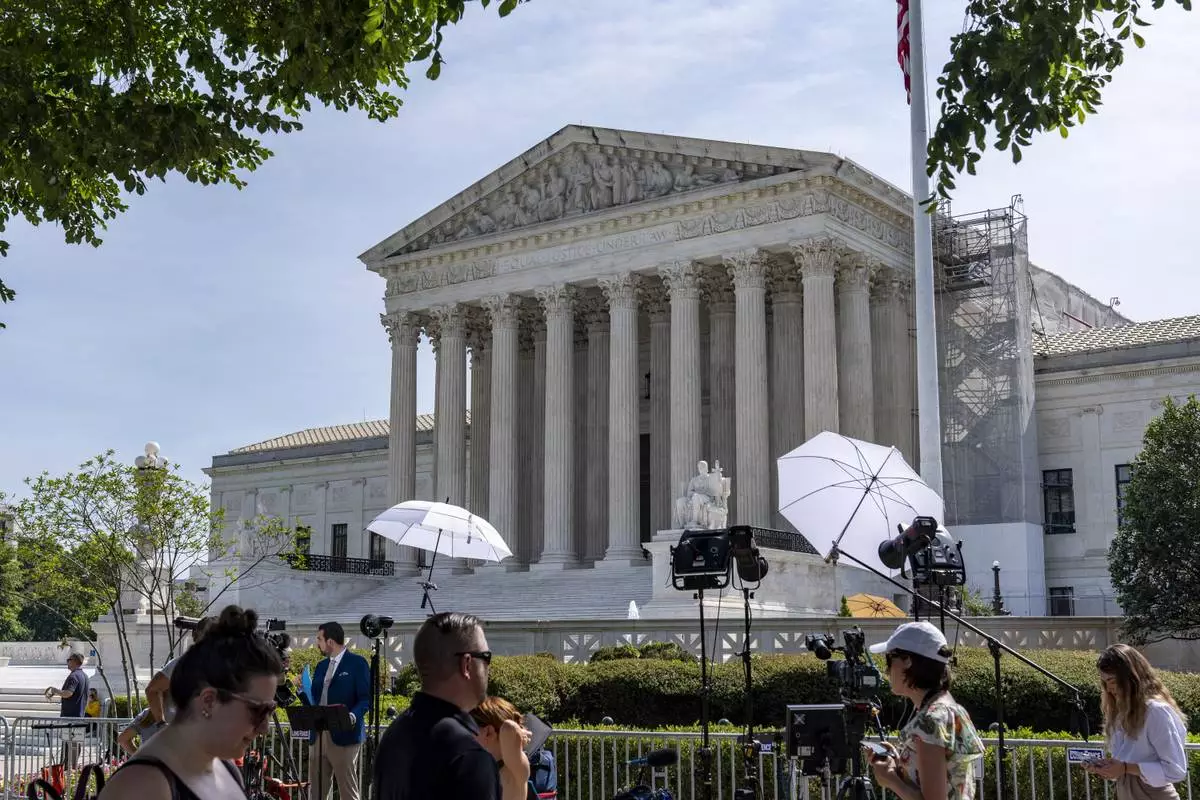
Journalists await the Court's decisions outside the Supreme Court, Wednesday, June 26, 2024, in Washington. (AP Photo/Alex Brandon)
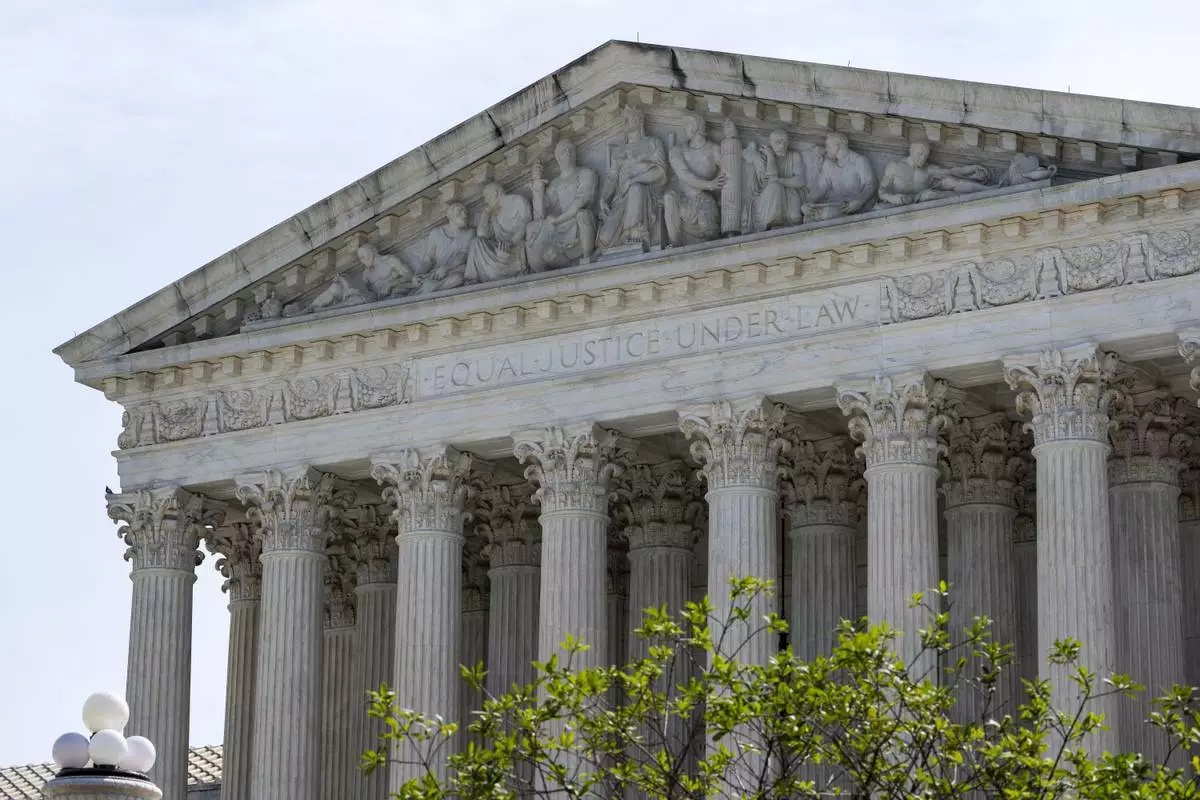
The Supreme Court building is seen, Wednesday, June 26, 2024, in Washington. (AP Photo/Alex Brandon)
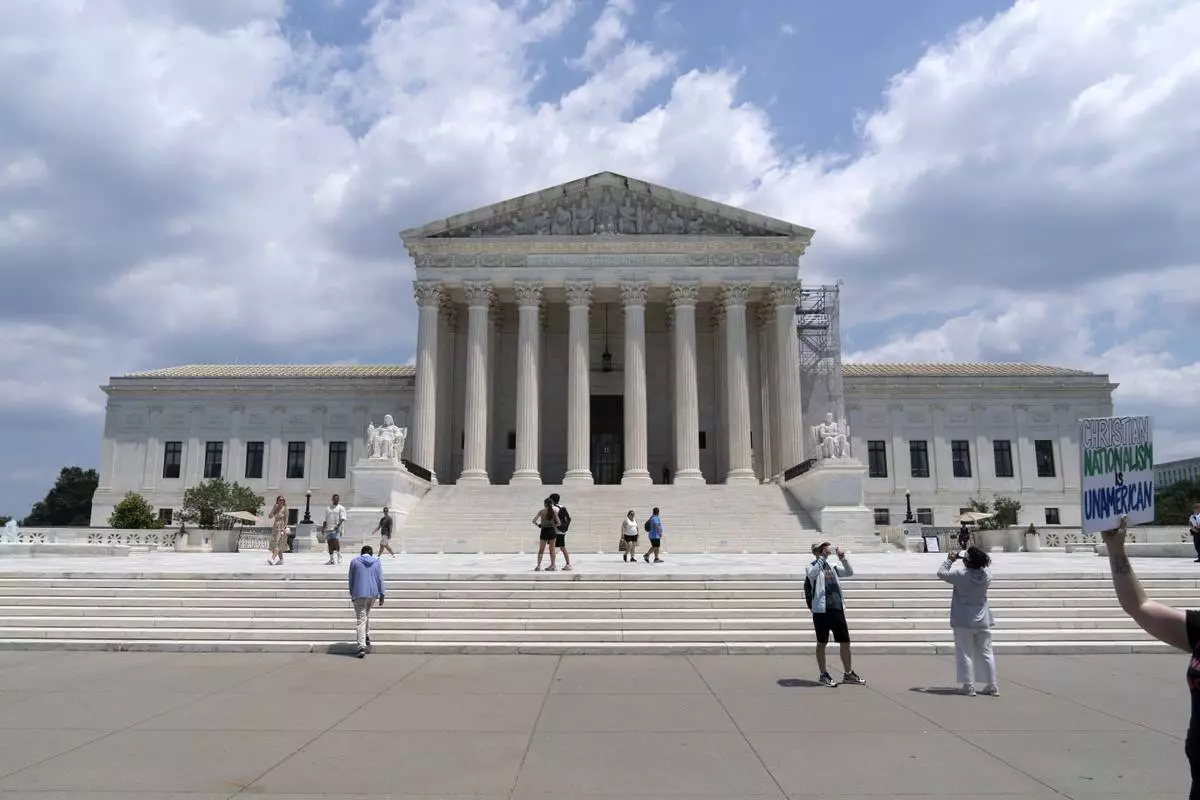
Visitors pose for photographs outside the U.S. Supreme Court Tuesday, June 18, 2024, in Washington. ( AP Photo/Jose Luis Magana)

The Supreme Court rules for Biden administration in a social media dispute with conservative states
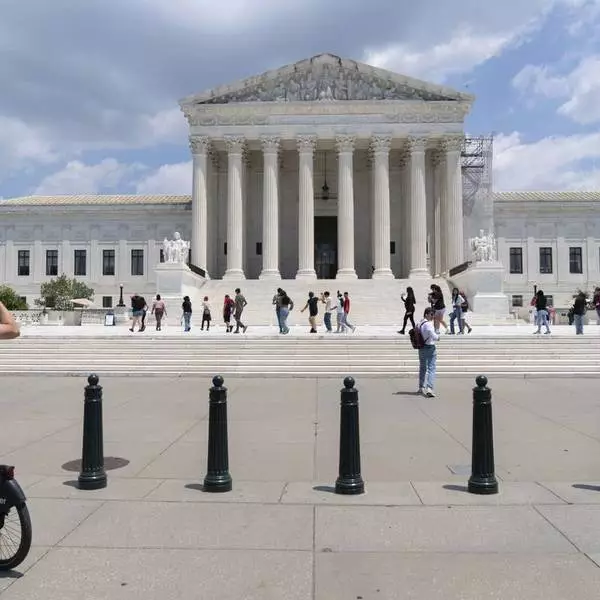
The Supreme Court rules for Biden administration in a social media dispute with conservative states
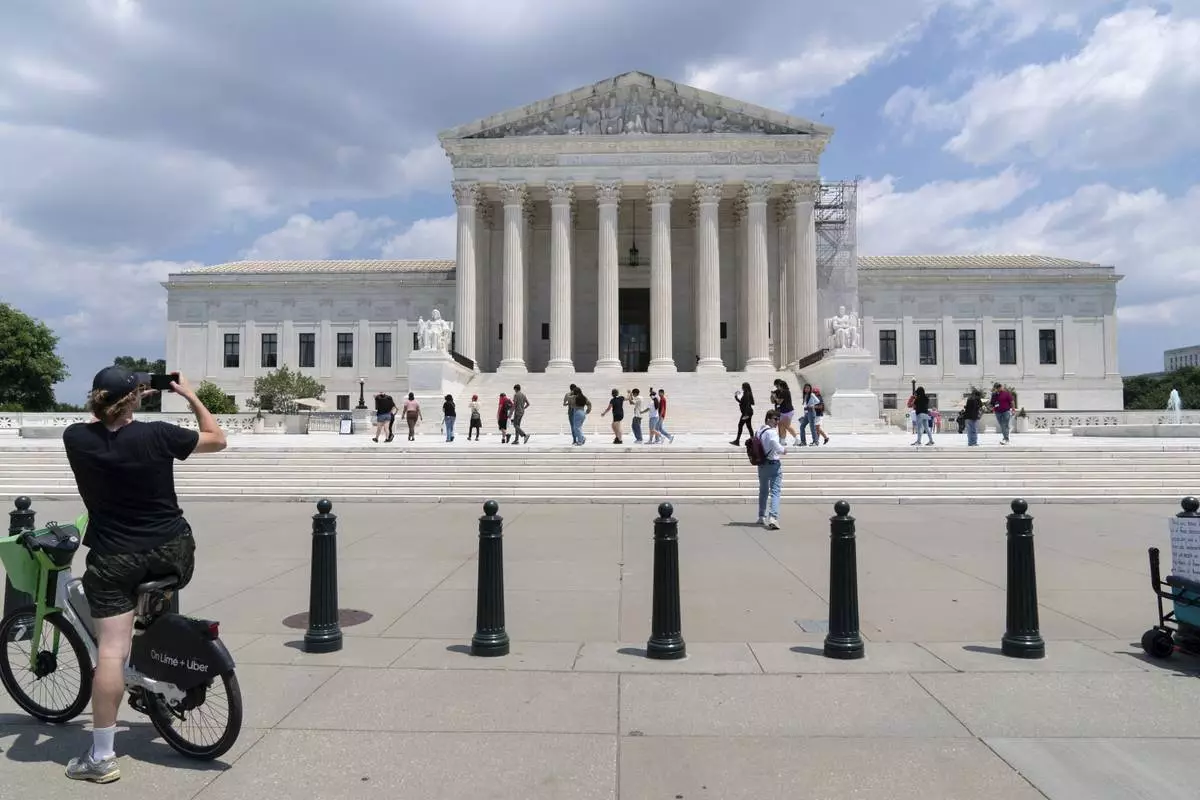
Visitors pose for photographs at the U.S. Supreme Court Tuesday, June 18, 2024, in Washington. ( AP Photo/Jose Luis Magana)
DUBAI, United Arab Emirates (AP) — Seesawing results released early Saturday in Iran’s presidential election put the race between little-known reformist Masoud Pezeshkian and hard-liner Saeed Jalili, with the lead trading between the two men as a runoff vote appeared likely.
Iranian state television reported the results which did not initially put either man in a position to win Friday's election outright, potentially setting the stage for a second round of voting to replace the late hard-line President Ebrahim Raisi who died in a helicopter crash last month.
So far, no turnout figures have been offered— a crucial component of whether Iran's electorate backs its Shiite theocracy after years of economic turmoil and mass protests.
Voters faced a choice between the three hard-line candidates and Pezeshkian, a heart surgeon.
After counting over 19 million votes, Pezeshkian had 8.3 million while Jalili held 7.18 million. Another candidate, hard-line parliament speaker Mohammad Bagher Qalibaf, had some 2.67 million votes while Shiite cleric Mostafa Pourmohammadi had over 158,000 votes.
Iranian law requires that a winner gets more than 50% of all votes cast. If not, the race’s top two candidates will advance to a runoff a week later. There’s been only one runoff presidential election in Iran’s history: in 2005, when hard-liner Mahmoud Ahmadinejad bested former President Akbar Hashemi Rafsanjani.
As has been the case since the 1979 Islamic Revolution, women and those calling for radical change have been barred from running, while the vote itself will have no oversight from internationally recognized monitors.
There had been calls for a boycott, including from imprisoned Nobel Peace Prize laureate Narges Mohammadi. Mir Hossein Mousavi, one of the leaders of the 2009 Green Movement protests who remains under house arrest, has also refused to vote along with his wife, his daughter said.
There’s also been criticism that Pezeshkian represents just another government-approved candidate. In a documentary on the reformist candidate aired by state TV, one woman said her generation was “moving toward the same level” of animosity with the government that Pezeshkian’s generation had in the 1979 revolution.
Raisi, 63, died in the May 19 helicopter crash that also killed the country’s foreign minister and others. He was seen as a protégé of Iran’s Supreme Leader Ayatollah Ali Khamenei and a potential successor. Still, many knew him for his involvement in the mass executions that Iran conducted in 1988, and for his role in the bloody crackdowns on dissent that followed protests over the death of Mahsa Amini, a young woman detained by police over allegedly improperly wearing the mandatory headscarf, or hijab.
The voting came as wider tensions have gripped the Middle East over the Israel-Hamas war in the Gaza Strip.
In April, Iran launched its first-ever direct attack on Israel over the war in Gaza, while militia groups that Tehran arms in the region — such as the Lebanese Hezbollah and Yemen’s Houthi rebels — are engaged in the fighting and have escalated their attacks.
Meanwhile, the Islamic Republic continues to enrich uranium at near weapons-grade levels and maintains a stockpile large enough to build — should it choose to do so — several nuclear weapons.
Despite the recent unrest, there was only one reported attack around the election. Gunmen opened fire on a van transporting ballot boxes in the restive southeastern province of Sistan and Baluchestan, killing two police officers and wounding others, the state-run IRNA news agency reported. The province regularly sees violence between security forces and the militant group Jaish al-Adl, as well as drug traffickers.
Karimi reported from Tehran, Iran.
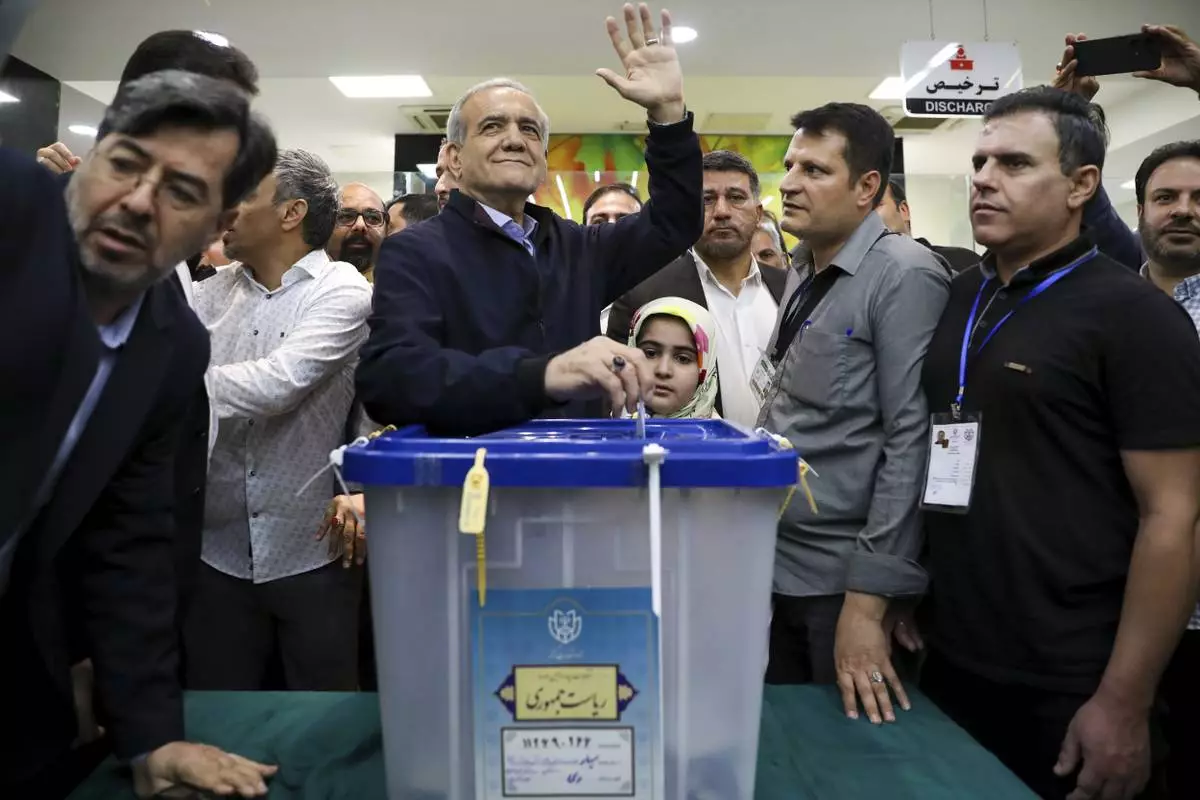
In this photo provided by Iranian Students' News Agency, ISNA, reformist candidate for the Iranian presidential election Masoud Pezeshkian casts his ballot as he waves to media in a polling station, in Tehran, Iran, Friday, June 28, 2024. Iranians are voting in a snap election to replace the late hard-line President Ebrahim Raisi. (Majid Khahi, ISNA via AP)
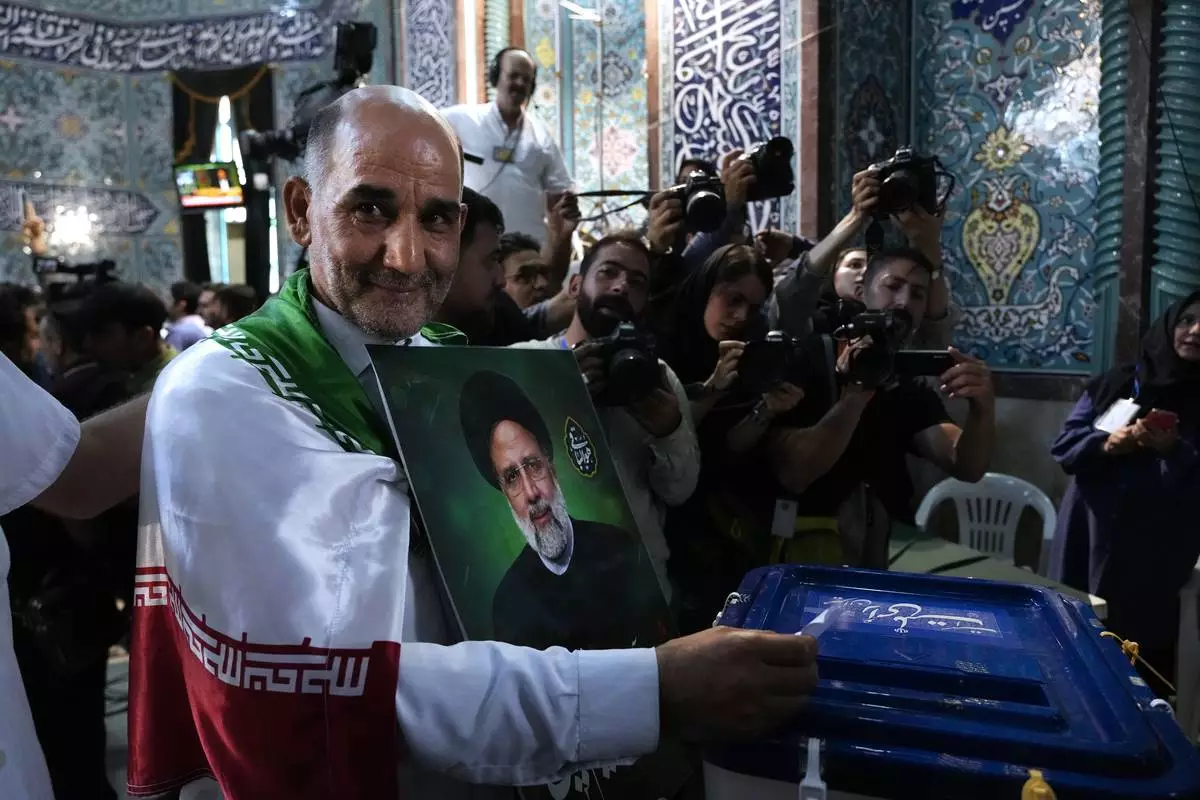
A man casts his ballot during the presidential election as he holds a picture of the late President Ebrahim Raisi in a polling station, in Tehran, Iran, Friday, June 28, 2024. Iranians were voting Friday in a snap election to replace the late President Ebrahim Raisi, killed in a helicopter crash last month, as public apathy has become pervasive in the Islamic Republic after years of economic woes, mass protests and tensions in the Middle East. (AP Photo/Vahid Salemi)
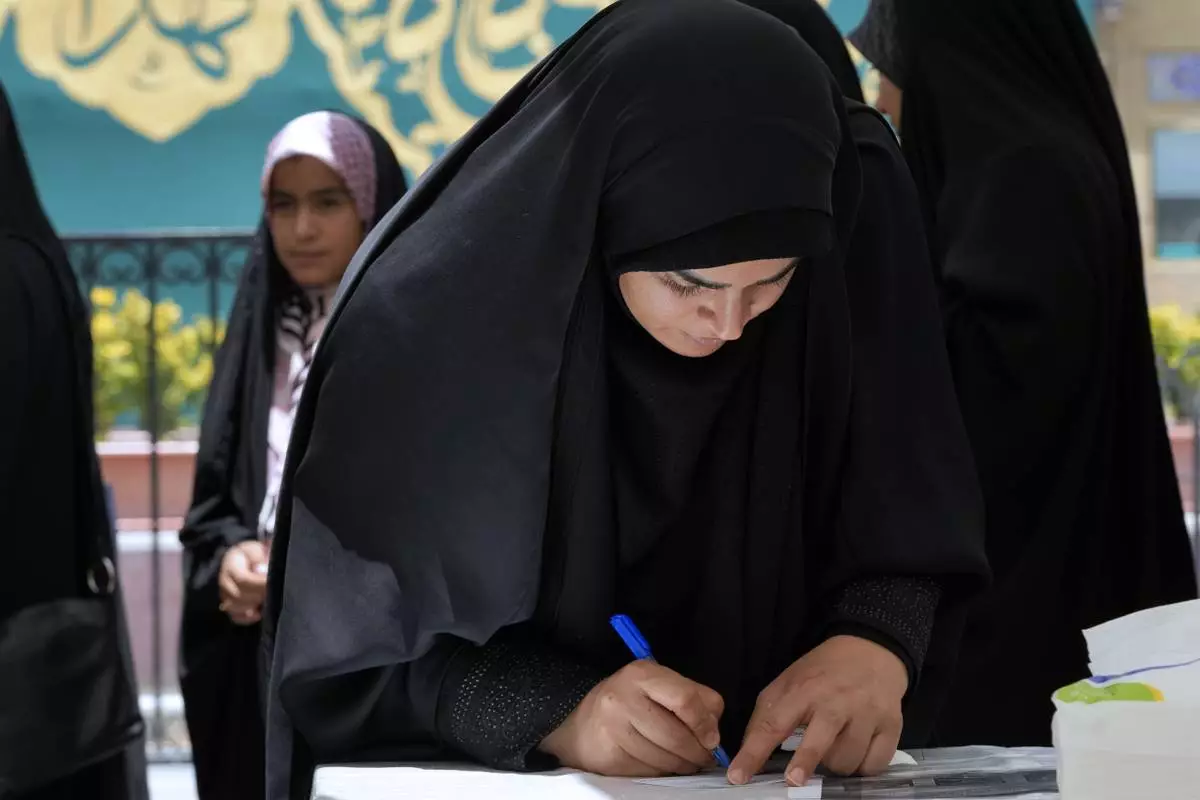
A woman fills out her ballot during the Iranian presidential election in a polling station at the shrine of Saint Saleh in northern Tehran, Iran, Friday, June 28, 2024. Iranians were voting Friday in a snap election to replace the late President Ebrahim Raisi, killed in a helicopter crash last month, as public apathy has become pervasive in the Islamic Republic after years of economic woes, mass protests and tensions in the Middle East. (AP Photo/Vahid Salemi)
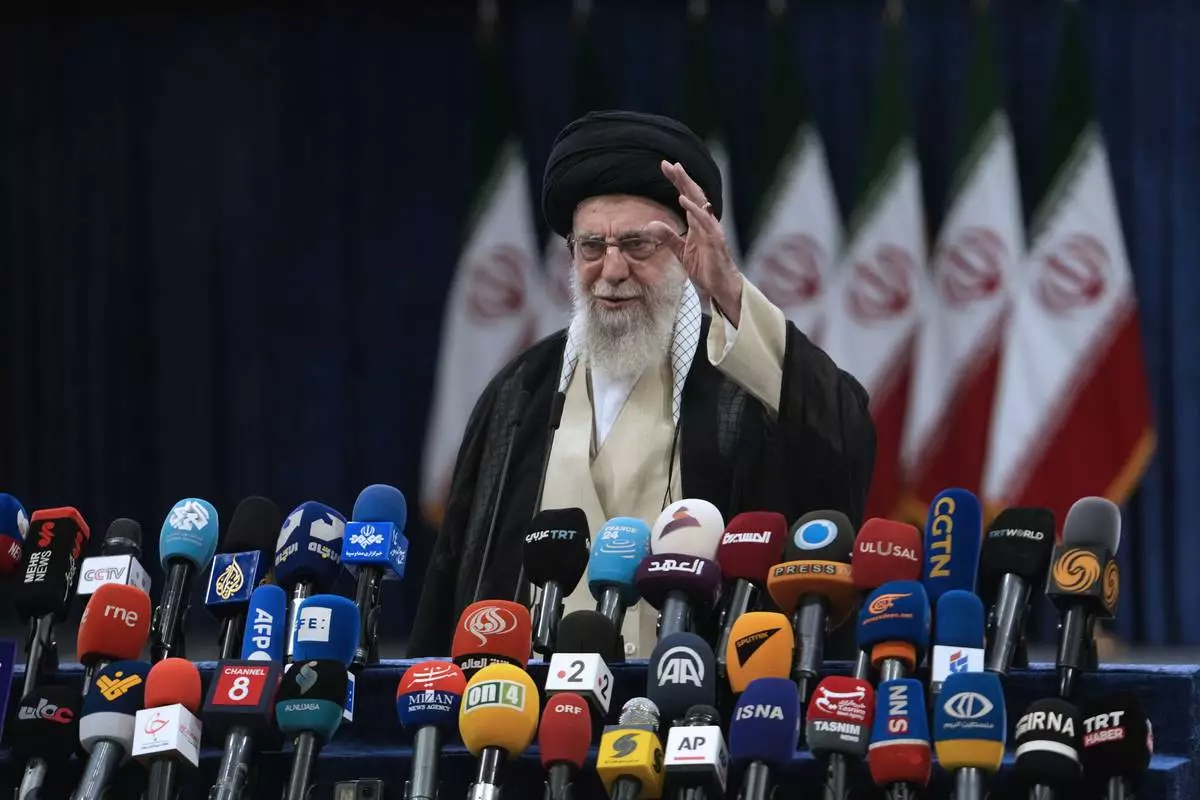
Iranian Supreme Leader Ayatollah Ali Khamenei waves to media after casting his vote during the presidential election in Tehran, Iran, Friday, June 28, 2024. Iranians were voting Friday in a snap election to replace the late President Ebrahim Raisi, killed in a helicopter crash last month, as public apathy has become pervasive in the Islamic Republic after years of economic woes, mass protests and tensions in the Middle East. (AP Photo/Vahid Salemi)
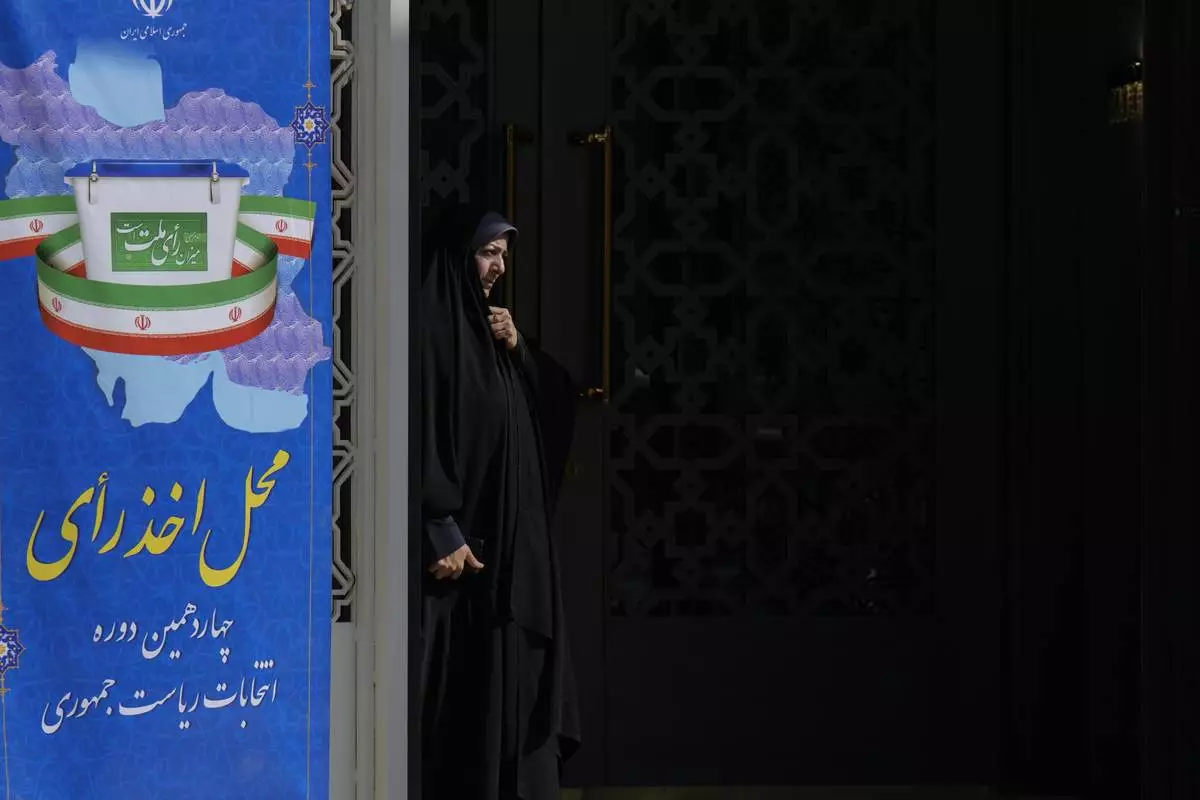
A woman prepares to casts her ballot during the presidential election at a polling station inside the Iranian embassy in Baghdad, Iraq, Friday, June 28, 2024. Iranians are voting in a presidential election to replace the late President Ebrahim Raisi, killed in a helicopter crash in May along with the country's foreign minister and several other officials. (AP Photo/Hadi Mizban)

Iranian Supreme Leader Ayatollah Ali Khamenei arrives to vote for the presidential election, in Tehran, Iran, Friday, June 28, 2024. Iranians voted Friday in a snap election to replace the late hard-line President Ebrahim Raisi, with the race's sole reformist candidate vowing to seek "friendly relations" with the West in an effort to boost his campaign. (AP Photo/Vahid Salemi)

A woman prepares to casts her ballot during the presidential election at the Iranian consulate in Basra southeast of Baghdad, Iraq, Friday, June 28, 2024. Iranians are voting in a presidential election to replace the late President Ebrahim Raisi, killed in a helicopter crash in May along with the country's foreign minister and several other officials. (AP Photo/Nabil al-Jourani)
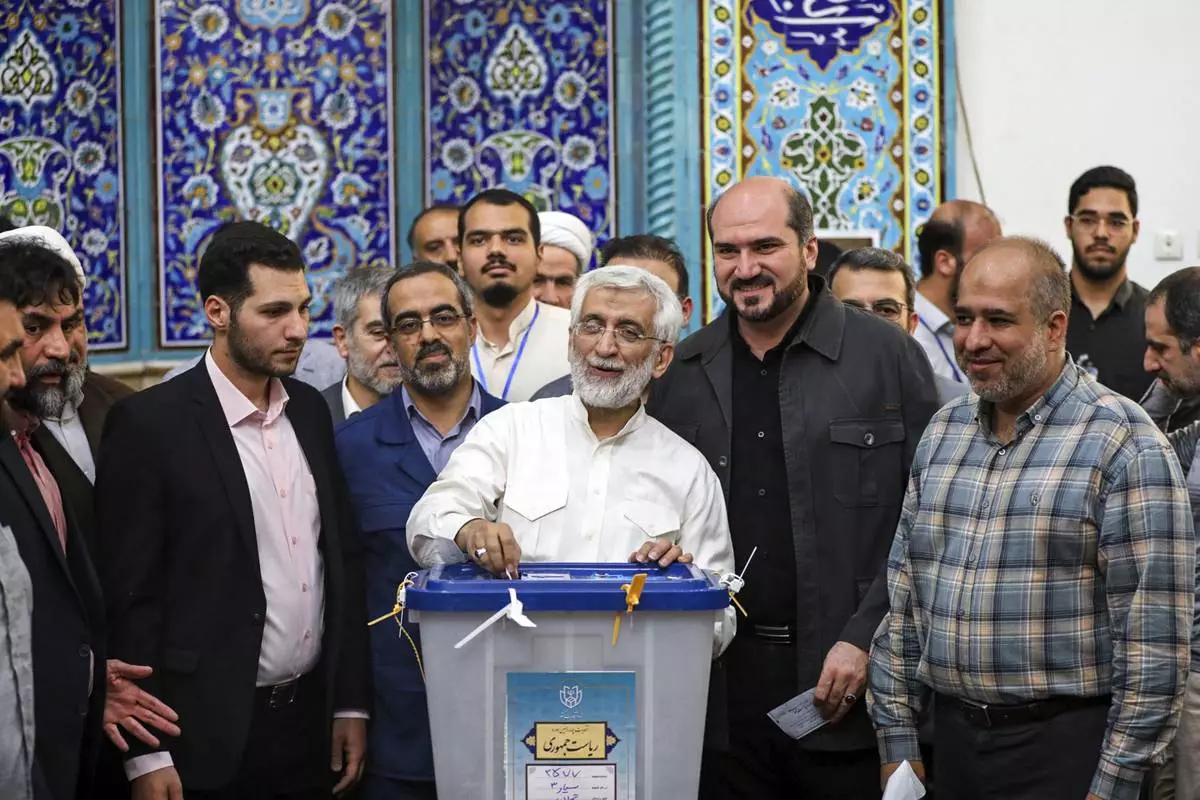
In this photo provided by Iranian Students' News Agency, ISNA, hard-line former Iranian senior nuclear negotiator and candidate for the presidential election Saeed Jalili casts his ballot in a polling station, in Tehran, Iran, Friday, June 28, 2024. Iranians are voting in a snap election to replace the late hard-line President Ebrahim Raisi. (Alireza Sotakabr, ISNA via AP)








